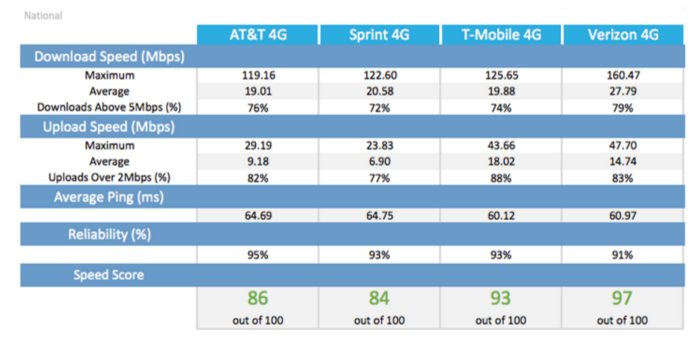Sprint LTE Plus improved its network quality, but the Overland Park, Kansas-based carrier still came in fourth
In its annual ranking of carrier network speeds around the United States, PC Magazine declared Verizon Wireless the winner for the third straight year.
Based on drive tests in and between 30 major metropolitan areas, T-Mobile US earned the No. 2 spot followed by Sprint and, in fourth place, AT&T Mobility.
Here’s a look at the maximum average 4G download speeds:
- Verizon Wireless came in with 160.47 Mbps;
- T-Mobile US supported 125.65 Mbps;
- Sprint came in with 122.60 Mbps; and
- AT&T Mobility scored 119.16 Mbps
Those results are based on pure download speeds. The field testers also considered average upload speed, ping and reliability to produce a “speed score.” Based on that metric, Sprint came in fourth, while AT&T Mobility moved up to third place. Verizon Wireless and T-Mobile US maintained respective first- and second-place spots.
PC Magazine conducted its tests using Samsung Galaxy S6 Edge+ smartphones and custom testing software put together by Ookla.
Subscribe now to get the daily newsletter from RCR Wireless News
Commentary on Sprint and Verizon
And while it didn’t win nationwide, Sprint is “finally back,” based on the test analysis.
“We saw the beginning of this last year, but it really kicked into gear in 2016 with Sprint’s new LTE Plus system, which uses two merged 20 [megahertz] channels to massively boost download speeds. Sprint’s network is much more geared to downloads than to uploads, but the company argues that most smartphone users’ lifestyles are, too,” the report’s authors said. “Factor in how cheap Sprint’s service plans are right now, and it becomes a carrier worth considering again.”
More on Verizon: “Verizon continues to lead through a combination of deep pockets, forward thinking, and a focus on building a network rather than trying to find quick-fix wins through corporate mergers,” the magazine reported. “The company added to its spectrum bank with a $10 billion purchase in 2015, giving it 40 [megahertz] of the most commonly used LTE spectrum in 92 of the top 100 U.S. cities. This year, it brought 2×20 MHz carrier aggregation and 4×4 [multiple-input and multiple-output] antennas to the table, technologies which sped up its network without requiring it to build or lease new towers or airwaves.”

